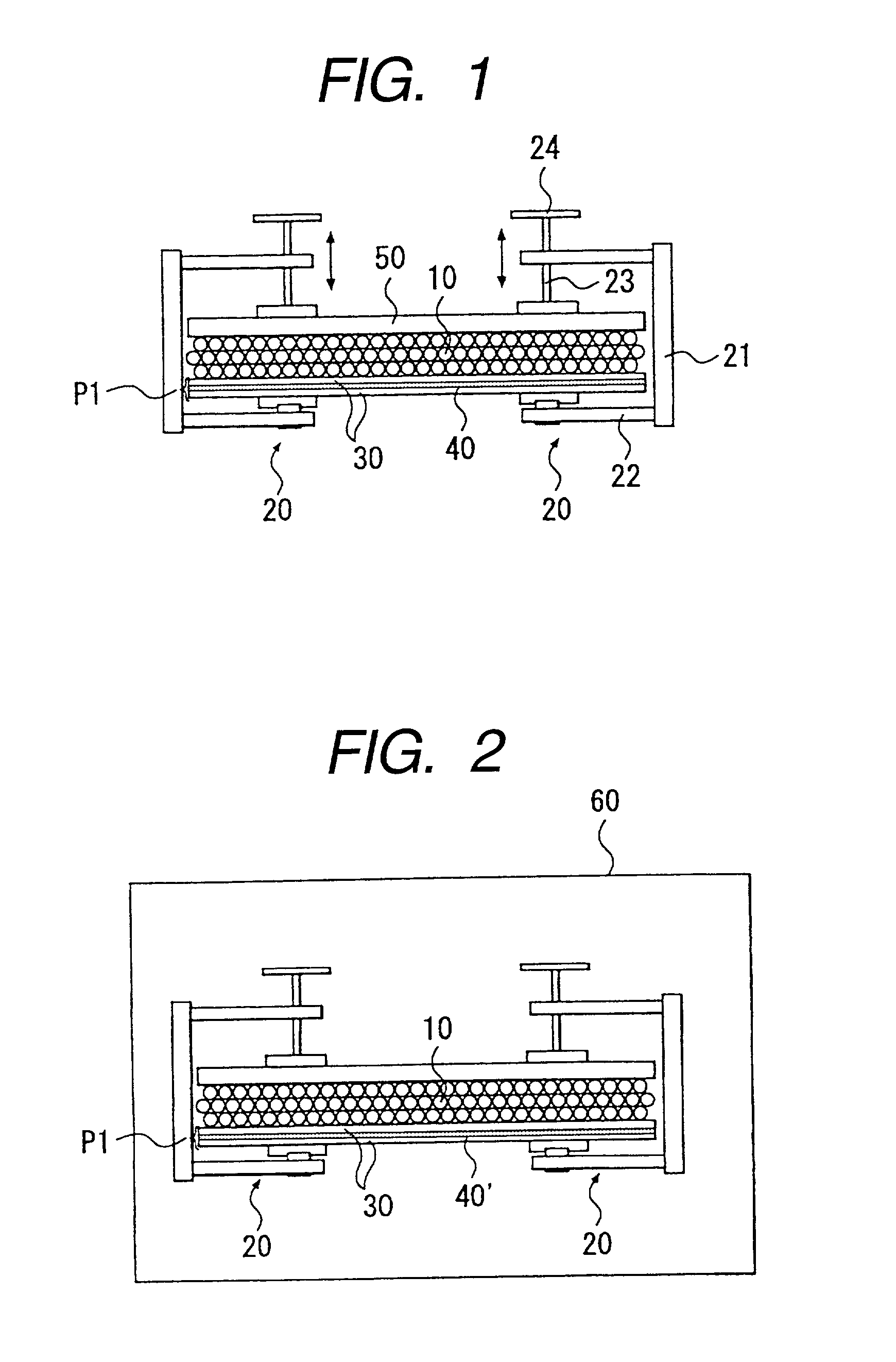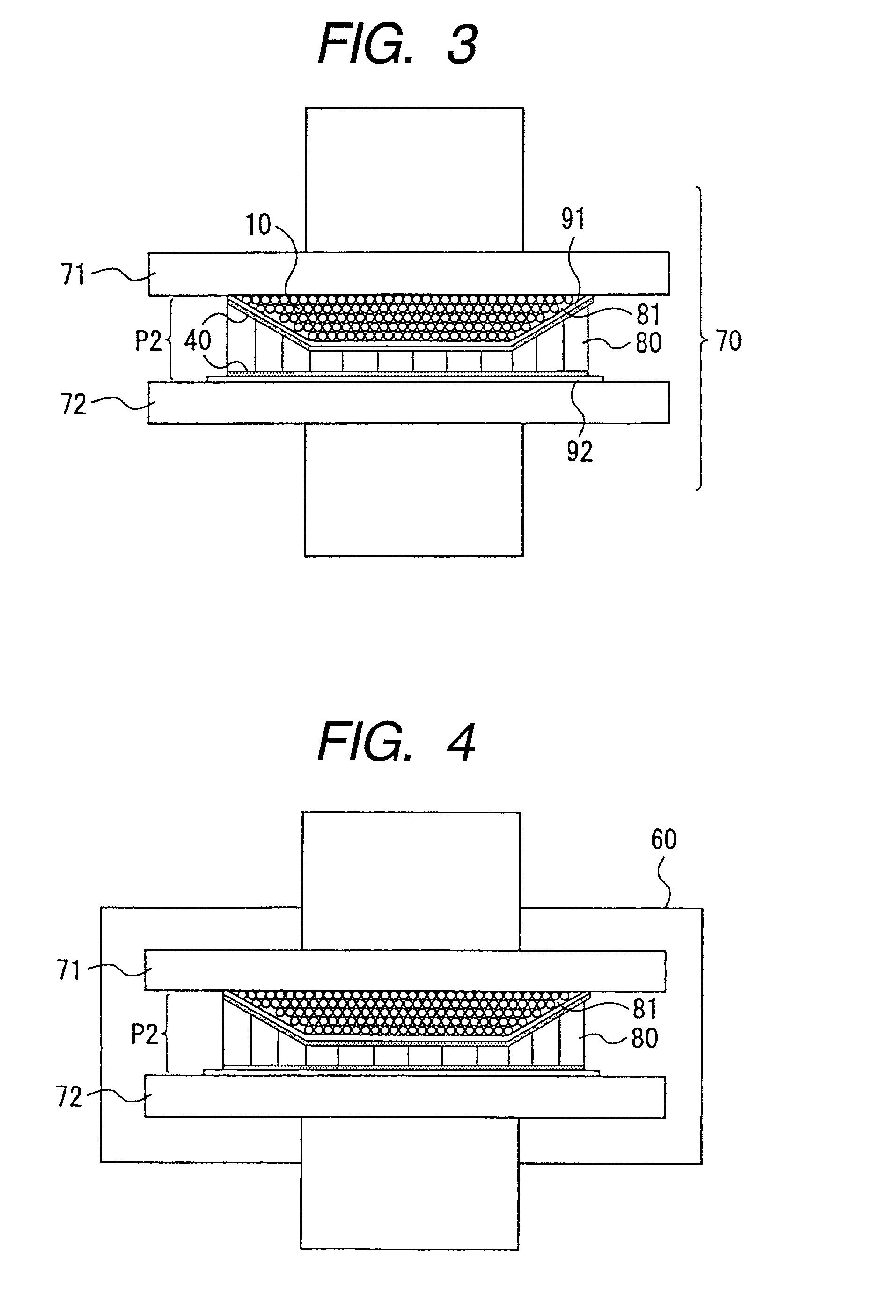Method for manufacturing a structure
a manufacturing method and structure technology, applied in the direction of manufacturing tools, ceramic shaping cores, synthetic resin layered products, etc., can solve the problems of insufficient bonding, high construction equipment or operation cost, and inability to bond compact components with each other in autoclaves, etc., to achieve excellent cost effectiveness and uniform pressure
- Summary
- Abstract
- Description
- Claims
- Application Information
AI Technical Summary
Benefits of technology
Problems solved by technology
Method used
Image
Examples
first embodiment
[0109]In this embodiment, with reference to FIG. 1, description will be made on a method for bonding two flat plates 30 as adherends by use of spherical bodies 10 made of silicon rubber and C-clamps 20.
[0110]First, surface treatment is carried out on bonded surfaces of the two flat plates 30. This surface treatment is carried out in order to eliminate inorganic matter such as rust or organic matter such as finger marks adhering to the respective bonded surfaces and impeding bonding. The surface treatment may be carried out in a mechanical method in which the respective bonded surfaces are polished and then degreased with a solvent; or in a chemical method in which chemicals are applied onto the bonded surfaces after degreasing with a solvent.
[0111]Next, a bonding adhesive 40 is applied onto the respective bonded surfaces of the two flat plates 30, and the bonded surfaces are laminated to each other (lamination step). In this embodiment, a room-temperature setting bonding adhesive su...
second embodiment
[0130]Next, description will be made on the second embodiment with reference to FIG. 2. This embodiment provides a method in which two flat plates 30 as adherends are bonded with each other by use of silicon balls 10 and C-clamps 20 in the same manner as in the first embodiment, and a bonding adhesive is hardened by heating.
[0131]In this embodiment, movable portions 23 of the C-clamps 20 each of made of an iron alloy are moved toward fixed portions 22 by screw-type handles 24 so as to apply pressure to a laminate P1 through a pressure plate 50 and the silicon balls 10. After that, the C-clamps 20, the pressure plate 50, the silicon balls 10 and the laminate P1 are heated at 180° C. by a heating tank 60 (see FIG. 2).
[0132]The silicon balls 10 have, in themselves, heat resistance excellent enough to withstand temperature in a range of from −55° C. to 250° C. (see Table-1), and a property to expand in accordance with heating. Accordingly, the laminate P1 has further pressurized by the ...
third embodiment
[0137]In this embodiment, with reference to FIG. 3, description will be made on a method in which skins 91 and 92 are bonded respectively with the upper and lower surfaces of a honeycomb core 80 so as to form a honeycomb sandwich panel by use of silicon balls 10 and a pressing machine 70. A recess portion 81 is provided on the upper surface side of the honeycomb core 80 as shown in FIG. 3. The upper skin 91 to be bonded with the upper surface of the honeycomb core 80 is molded into the same shape as the upper surface shape having the recess portion 81. On the other hand, the lower skin 92 like a flat plate is bonded with the lower surface of the honeycomb core 80.
[0138]First, surface treatment is carried out on the respective bonded surfaces of the honeycomb core 80, the upper skin 91 and the lower skin 92. The surface treatment can be carried out in a manner similar to that in the first embodiment. Next, a bonding adhesive 40 is applied onto the respective bonded surfaces, and the ...
PUM
| Property | Measurement | Unit |
|---|---|---|
| Temperature | aaaaa | aaaaa |
| Fraction | aaaaa | aaaaa |
| Fraction | aaaaa | aaaaa |
Abstract
Description
Claims
Application Information
 Login to View More
Login to View More - R&D
- Intellectual Property
- Life Sciences
- Materials
- Tech Scout
- Unparalleled Data Quality
- Higher Quality Content
- 60% Fewer Hallucinations
Browse by: Latest US Patents, China's latest patents, Technical Efficacy Thesaurus, Application Domain, Technology Topic, Popular Technical Reports.
© 2025 PatSnap. All rights reserved.Legal|Privacy policy|Modern Slavery Act Transparency Statement|Sitemap|About US| Contact US: help@patsnap.com



